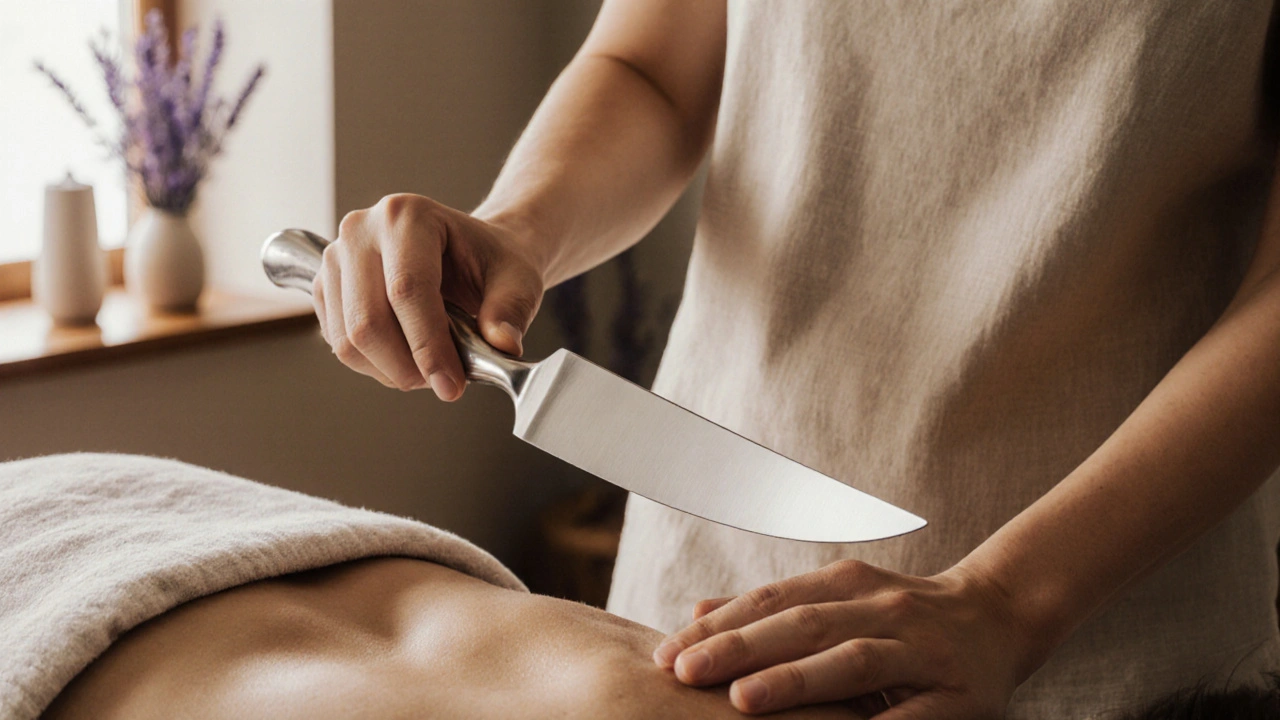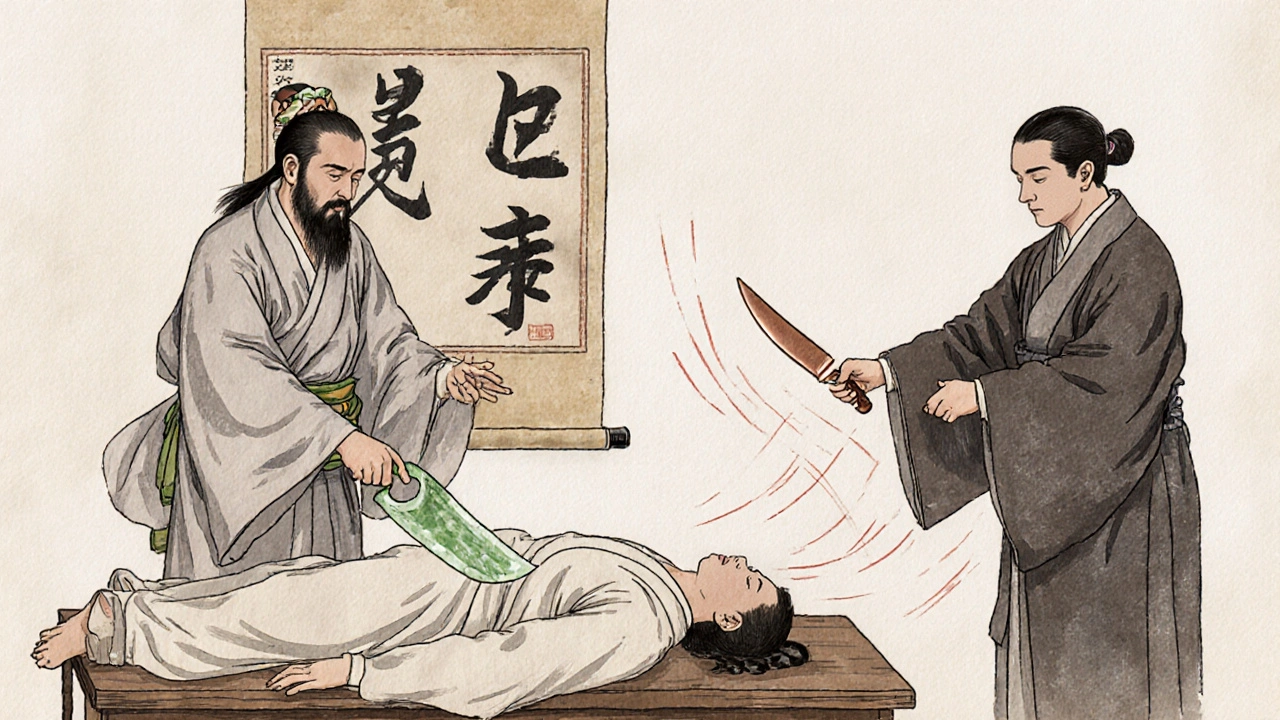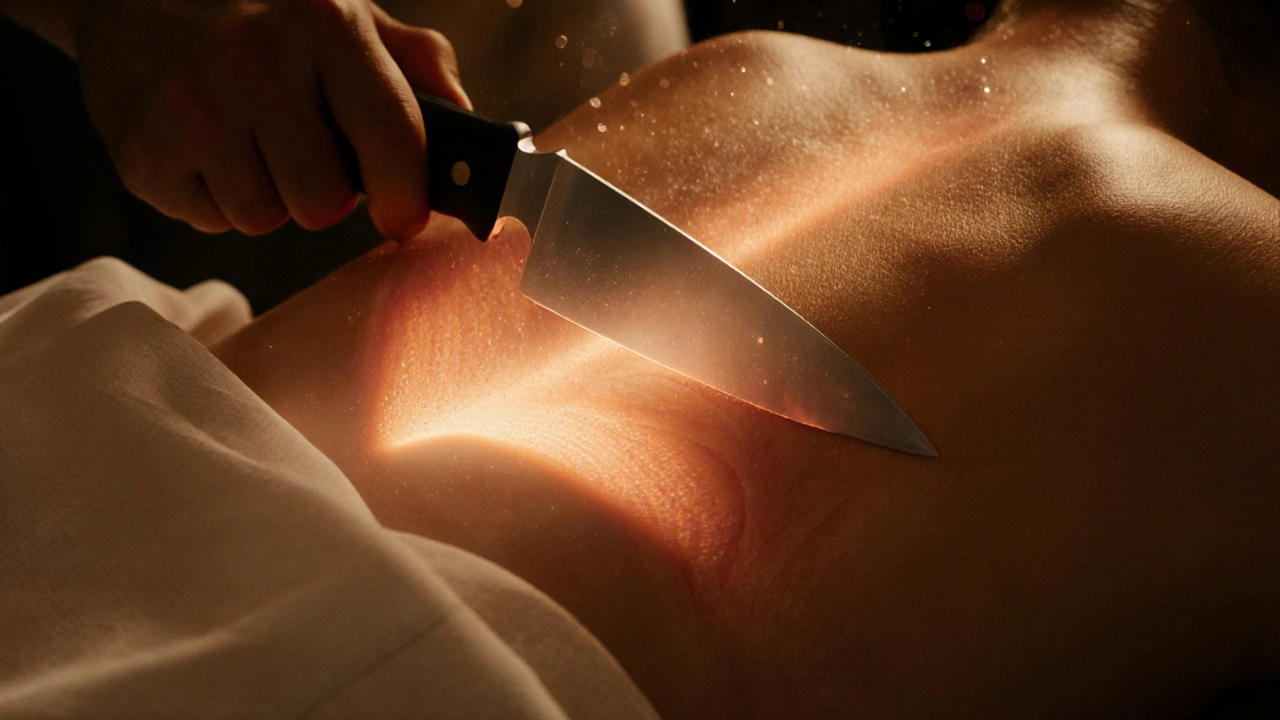Knife Massage: Healing Benefits, History, and How It Works
 Oct, 21 2025
Oct, 21 2025
Knife Massage Safety Checker
Check Your Safety
Before trying knife massage, please check if it's safe for you based on your health conditions.
When you hear Knife Massage is a therapeutic practice that uses specially designed blunt blades to apply pressure and glide over the skin, you might picture a scene from a thriller. In reality, it’s a centuries‑old bodywork method that blends the precision of a scalpel with the soothing intent of a traditional massage. This article uncovers what the technique really is, where it comes from, the benefits and risks, and how to decide if it belongs in your wellness routine.
What Exactly Is Knife Massage?
At its core, knife massage involves a set of polished, rounded‑edge knives-often made of stainless steel or jade-used to roll, tap, and glide across muscle groups. The practitioner holds the blade like a paddle, allowing the weight of the tool to generate deep, uniform pressure without the need for excessive force from the hands. Because the blade’s surface is smooth, it minimizes friction while still delivering a sensation similar to a deep‑tissue stretch.
Historical Roots and Cultural Context
Historical records trace the practice back to ancient China, where healers employed copper or jade knives in rituals aimed at balancing qi. In the early 1900s, a Japanese therapist named Takeshi Nishida refined the method, introducing the concept of “blade flow” to unlock fascia layers hidden beneath the skin. Over the decades, the technique migrated west, finding a niche among holistic practitioners who valued its ability to combine Myofascial Release with a visually striking ritual.
How the Technique Works
During a session, the therapist first warms up the area with light Swedish Massage strokes. Then, a blunt knife is placed flat against the skin. The practitioner guides the blade in slow, sweeping motions, applying pressure that can range from 2 to 7 kilograms, depending on the client’s tolerance. The weight of the tool, combined with gravity, helps to stretch scar tissue, improve blood flow, and stimulate mechanoreceptors that signal the nervous system to release tension.
Benefits Reported by Practitioners and Clients
- Enhanced circulation: The glide action promotes venous return, reducing swelling in limbs.
- Deep fascial release: The blade’s smooth surface can reach layers that hands struggle to access.
- Pain reduction: Anecdotal reports show relief from chronic neck, shoulder, and lower‑back pain.
- Stress relief: The rhythmic motion produces a meditative effect similar to Reiki sessions.
- Improved range of motion: Athletes often notice greater flexibility after a series of treatments.
While many clients experience a “tingling” or “warmth” sensation that many describe as therapeutic, the evidence base is still limited. Small pilot studies conducted in 2022 and 2023 reported statistically significant improvements in muscle elasticity scores after four weekly sessions. Larger, randomized trials are still pending.
Potential Risks and Contraindications
As with any bodywork that applies focused pressure, there are safety considerations:
- Open wounds or skin infections: The blade can aggravate lesions.
- Bleeding disorders: Even gentle pressure may trigger bruising.
- Severe osteoporosis: Fragile bones can fracture under unexpected stress.
- Pregnancy (first trimester): Hormonal changes make ligaments more lax, increasing injury risk.
Always disclose medical history before booking a session. Certified practitioners should conduct a thorough intake and adjust pressure accordingly.
Comparison with Other Bodywork Modalities
| Aspect | Knife Massage | Swedish Massage | Deep Tissue Massage | Cupping Therapy |
|---|---|---|---|---|
| Primary Tool | Blunt blade | Hands & forearms | Hands, elbows, forearms | Silicone or glass cups |
| Pressure Depth | Medium‑deep (gravity‑assisted) | Light‑to‑medium | Deep, target‑specific | Superficial (suction) |
| Typical Session Length | 45‑60 min | 60‑90 min | 60‑90 min | 20‑30 min per area |
| Key Benefit | Fascia release with visual focus | Relaxation, circulation | Chronic pain relief | Myofascial decompression |
| Common Contraindications | Skin lesions, bleeding disorders | Fever, acute inflammation | Recent surgery, fractures | Skin sensitivity, blood clotting issues |
The table shows why someone might choose knife massage over a more familiar technique: the visual focus and the ability to maintain consistent pressure without tiring the therapist’s hands.

What to Expect During Your First Session
A typical first appointment lasts about an hour. After a brief consultation, the therapist drapes the client in a warm sheet, exposing only the treatment area. The session begins with light effleurage to relax muscles, then the knife is introduced. You’ll feel a cool glide followed by a gentle press as the blade moves across the skin. Most people report a warm, “melted‑away” feeling after the final strokes.
Choosing a Qualified Practitioner
Because knife massage is a niche skill, not every massage therapist offers it. Look for these credentials:
- Certification from a recognized body such as the International Blade Therapy Association (IBTA).
- Training that includes anatomy, fascia science, and safety protocols.
- Positive client testimonials that mention both comfort and results.
- Insurance coverage or a clear liability disclaimer.
Don’t hesitate to ask about the sterilization process for the blades. Reputable clinics use medical‑grade stainless steel that can be autoclaved between clients.
Why DIY Knife Massage Isn’t Recommended
It might be tempting to buy a set of “massage knives” online and try the technique at home. However, without proper training you risk:
- Applying uneven pressure that could bruise or damage tissue.
- Inadvertently cutting the skin if the blade isn’t truly blunt.
- Missing subtle cues from the client’s nervous system that indicate discomfort.
Professional guidance ensures the tool is used safely and effectively, turning an eye‑catching novelty into a genuine healing practice.
Integrating Knife Massage Into a Holistic Routine
Many clients pair knife massage with complementary modalities:
- Acupressure points are often stimulated after the blade work to reinforce qi flow.
- Following a session with Aromatherapy using lavender oil can amplify relaxation.
- Gentle stretching or yoga post‑session helps lock in the increased range of motion.
Think of knife massage as one piece of a larger puzzle aimed at reducing chronic tension and improving overall vitality.
Future Directions and Research
Researchers at the University of Copenhagen are currently conducting a double‑blind study measuring cytokine levels before and after a series of knife‑massage treatments. Early data suggest a modest anti‑inflammatory effect, aligning with client reports of reduced soreness. As the evidence base expands, insurance companies may begin to recognize the modality alongside other manual therapies.

Final Thoughts
If you’re curious about a bodywork method that blends ancient philosophy with a modern, tactile experience, knife massage deserves a spot on your wellness radar. Its unique blend of pressure, visual focus, and fascia‑targeted action offers benefits that differ from standard massages. As always, prioritize a qualified practitioner, disclose health conditions, and treat the technique as a complement-not a replacement-to a balanced health regimen.
Is knife massage painful?
Most people describe the sensation as deep pressure rather than pain. The therapist adjusts intensity based on your feedback, and the blade’s smooth edge reduces the risk of tissue irritation.
Can I combine knife massage with other therapies?
Absolutely. Many clients follow a knife‑massage session with acupressure, aromatherapy, or gentle yoga to extend the benefits and promote relaxation.
How often should I schedule knife massage?
For newcomers, a weekly session for four weeks is typical. After that, a maintenance schedule of once a month often suffices to keep fascia supple.
What should I wear to a knife‑massage session?
Loose, breathable clothing is ideal. Most clinics will ask you to change into a provided sheet, exposing only the area being treated.
Is knife massage covered by health insurance?
Coverage varies by provider and region. Some plans treat it as a form of manual therapy, while others classify it as an alternative modality that isn’t reimbursed.
